

Latitude Theory
A personal place to jot things down, from pre-Kepler astronomy, to concepts based upon 'latitude', streams my belief, how our Universe works, why politics should; remaining curious as sub-atomic structure, places between news & comedy, Alaska style. Enjoying oceans, forests, and the mountains; personally would like to meet Richard Branson. World traveler born in the land of the midnight sun, seeing myself as thoroughly educated by mother nature and father time. Constantly exploring the world wide wilderness from the comfort of my couch as well as from a sled. A big fan of Google:Earth and the music genome project: Pandora. Tending to see myself as a persistent survivalist, a student of history, an addict of political commentary, and continuous seeker for any discovery in forgotten aspects of the natural universe; always twisting in my own version of satire or irony from time to time, like wringing out a towel. At times the naturalist, promoting conservation for future generations. Often worried that at the rate we're going there may be "one left" of once flourishing species; from whales to waterfowl, especially the grey wolf which has become extinct in many places. The theories presented tend to support a balanced view of wildlife management and may veer from political correctness purposefully to inspire thoughtful arguments. Most of all the belief is that responsible integration of a society with nature is possible through creative applications of technology. First experience with a computer was in 1980. Learned the basics of programming with an Apple ][c, owning almost every piece of software written for it before moving into the endless world of Guru errors on an Amiga 500. Custom chip sets rock. So does building computers from scratch. At one point called a geek, and nerd. Now look who's calling... Growing up, learning how to use a variety of different computing systems, most of the time went to libraries to read every book available and then alone in late night sessions slowly devouring a fridge full of pizza. Home schooled for the better part of my education. Graduated high school here in the Last Frontier, toward the end of the Cold War with the U.S.S.R. Working since the age of sixteen, after getting my first car. Couldn't decide on an apprenticeship or go to college. So my decision was to do both. Yes, a big fan of "Ironman" and a collector of all things Marvel. Over the years, learned that the internet tends to be an awesome way to make extra income through desktop publishing, design, and coding. Mobile web applications are now becoming the next "thing" as these interests expand. Currently working on a book, a movie script, and a collection of some short stories about living in Alaska. So far published some of my favorite recipes and a few pictures in Flickr. The belief is that social media has created an entirely new political landscape; it has joined groups into countries without borders. Following these developments daily is an obsession, especially concerning research and development for applications; always curious as to how they impact world commerce as well as public opinion. Also been hooked on researching the markets recently, out of a sheer blind mathematical ambition. Or perhaps at times my lunacy might sound more intelligent when arguing about economics. Believing that some ideas can be transplanted just about anywhere, my interests include everything from aircraft design to green energy. My heart has always jumped a beat when seeing new technological innovation. That's probably why my list of interesting products, companies and services is so long. Through it all, one of my favorite things to do is scroll through various data feeds, blogs, tweets, blips, posts, diggs, new sites, even wall notes and read about what's going on in the world. Always eager to entertain a new perspective and change latitudes. ::PRIVACY NOTICE:: Warning: Any person and/or institution and/or agent and/or agency of any governmental structure including but not limited to the United States Federal Government, simply put the content stored by this website address or any of its associated mirrors, that you do NOT have permission to utilize any of my profile information nor any of the content contained herein including, but not limited, theories, opinions, my contact list, to my photography, and/ or the comments made about my photo's or any other "picture" or art posted on my profile. You are hereby notified that you are strictly prohibited from disclosing, copying, distributing, disseminating, either by electronic storage or physical dissemination. The prohibitions also apply to your employee(s), agent(s), student(s) or any personnel under your direction or control. The contents of this profile are private and legally privileged and confidential information, and the violation of my personal privacy is punishable by law and unilateral consequences which will be made public. 5 U.S.C. § 552a, Public Law No. 93-579, (Dec. 31, 1974) International Copyright Act of 1891
Gunpowder. Gunpowder, also known as black powder, was the first chemical explosive and the only one known until the mid-19th century.
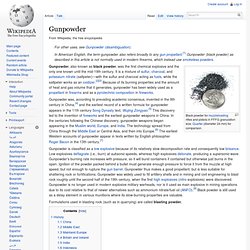
It is a mixture of sulfur, charcoal, and potassium nitrate (saltpeter)—with the sulfur and charcoal acting as fuels, while the saltpeter works as an oxidizer.[2][3] Because of its burning properties and the amount of heat and gas volume that it generates, gunpowder has been widely used as a propellant in firearms and as a pyrotechnic composition in fireworks. Gunpowder was, according to prevailing academic consensus, invented in the 9th century in China,[4] and the earliest record of a written formula for gunpowder appears in the 11th century Song Dynasty text, Wujing Zongyao.[5] This discovery led to the invention of fireworks and the earliest gunpowder weapons in China.
In the centuries following the Chinese discovery, gunpowder weapons began appearing in the Muslim world, Europe, and India. History[edit] Early Chinese rocket China[edit] Middle East[edit] C. Military technology. Military technology is the collection of equipment, vehicles, structures and communication systems that are designed for use in warfare.
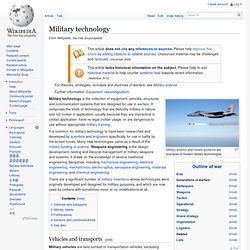
It comprises the kinds of technology that are distinctly military in nature and not civilian in application, usually because they are impractical in civilian application, have no legal civilian usage, or are dangerous to use without appropriate military training. It is common for military technology to have been researched and developed by scientists and engineers specifically for use in battle by the armed forces. Agricultural science. Agricultural science is a broad multidisciplinary field of biology that encompasses the parts of exact, natural, economic and social sciences that are used in the practice and understanding of agriculture.
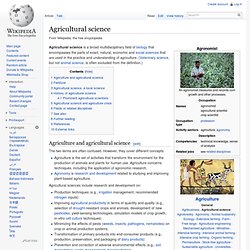
(Veterinary science, but not animal science, is often excluded from the definition.) Agriculture and agricultural science[edit] The two terms are often confused. However, they cover different concepts: Agriculture is the set of activities that transform the environment for the production of animals and plants for human use. Crop rotation. Satellite image of circular crop fields in Kansas in late June 2001.
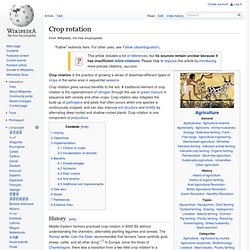
Healthy, growing crops are green. Corn would be growing into leafy stalks by then. Sorghum, which resembles corn, grows more slowly and would be much smaller and therefore, (possibly) paler. Wheat is a brilliant yellow as harvest occurs in June. Fields of brown have been recently harvested and plowed under or lie fallow for the year. Livestock transportation. Sheep in a B Double truck, Moree, NSW, Australia Twelve pigs being transported to an auction sale.
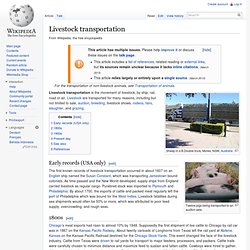
Seedbank. Seedbank at the Western Regional Plant Introduction Station A seedbank (or seed bank) stores seeds as a source for planting in case seed reserves elsewhere are destroyed.
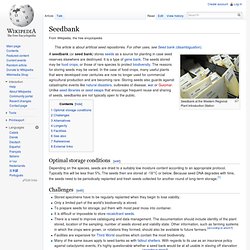
It is a type of gene bank. The seeds stored may be food crops, or those of rare species to protect biodiversity. The reasons for storing seeds may be varied. In the case of food crops, many useful plants that were developed over centuries are now no longer used for commercial agricultural production and are becoming rare. Optimal storage conditions[edit] Depending on the species, seeds are dried to a suitably low moisture content according to an appropriate protocol. Challenges[edit] Stored specimens have to be regularly replanted when they begin to lose viability.Only a limited part of the world's biodiversity is stored.To prepare seeds for storage, put them with moist peat moss into container.It is difficult or impossible to store recalcitrant seeds.There is a need to improve cataloguing and data management.
Refrigerator. Food in a refrigerator with its door open A side-by side refrigerator with an icemaker A refrigerator (colloquially fridge) is a common household appliance that consists of a thermally insulated compartment and a heat pump (mechanical, electronic, or chemical) that transfers heat from the inside of the fridge to its external environment so that the inside of the fridge is cooled to a temperature below the ambient temperature of the room.

Refrigeration is an essential food storage technique in developed countries. Agricultural machinery. Agricultural machinery is machinery used in the operation of an agricultural area or farm.
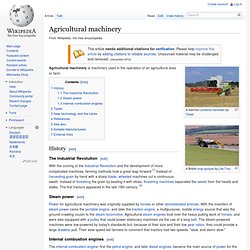
History[edit] Forge. A blacksmith's coal forge Wooden smithy in Opole, Upper Silesia, Poland Types of forges[edit] Coal/coke/charcoal forge[edit] Standard coal forge Over thousands of years of forging, these devices have evolved in one form or another as the essential features of this type of forge:[citation needed] Tuyere — a pipe through which air can be forced into the fireBellows or blower — a means for forcing air into the tuyereHearth — a place where the burning fuel can be contained over or against the tuyere opening.

Tool and die maker. Job description[edit] Traditionally, working from engineering drawings, tool makers measure out the design on the raw material (usually metal), then cut it to size and shape using manually controlled machine tools (such as Lathes, milling machines, grinding machines, and jig grinders) and hand tools (such as Files,hones,and stones.

Many tool makers now use computer-aided design,and computer-aided machining,to perform these tasks. Tool making[edit] Tool making typically means making tooling used to produce products. Common tools include metal forming rolls, lathe bits, milling cutters, and form tools. Die making[edit] Metallurgy. Georgius Agricola, author of De re metallica, an important early work on metal extraction Metallurgy is a domain of materials science and materials engineering that studies the physical and chemical behavior of metallic elements, their intermetallic compounds, and their mixtures, which are called alloys. Metallurgy is also the technology of metals: the way in which science is applied to the production of metals, and the engineering of metal components for use in products for consumers and manufacturers.
The production of metals involves the processing of ores to extract the metal they contain, and the mixture of metals, sometimes with other elements, to produce alloys. Metallurgy is distinguished from the craft of metalworking. Crystallography. A crystalline solid: atomic resolution image of strontium titanate. Brighter atoms are Sr and darker ones are Ti. Crystallography is the science that examines the arrangement of atoms in solids (see crystal structure). The word "crystallography" derives from the Greek words crystallon "cold drop, frozen drop," with its meaning extending to all solids with some degree of transparency, and grapho "I write. " Great Pyramid of Giza. The Great Pyramid of Giza (also known as the Pyramid of Khufu or the Pyramid of Cheops) is the oldest and largest of the three pyramids in the Giza Necropolis bordering what is now El Giza, Egypt. It is the oldest of the Seven Wonders of the Ancient World, and the only one to remain largely intact.
Based on a mark in an interior chamber naming the work gang and a reference to fourth dynasty Egyptian Pharaoh Khufu,[1][2] Egyptologists believe that the pyramid was built as a tomb over a 10 to 20-year period concluding around 2560 BC. Ancient Egyptian technology. Bibliotheca (Pseudo-Apollodorus) The Bibliotheca (Ancient Greek: Βιβλιοθήκη, Bibliothēkē, "library") is a compendium of myths and heroic legends, arranged in three books, generally dated to the first or second centuries AD.[1] It was known traditionally as the Library of Apollodorus, but the attribution is now regarded as false.
The Bibliotheca has been called "the most valuable mythographical work that has come down from ancient times".[2] An epigram recorded by Photius expressed its purpose: It has the following not ungraceful epigram: 'Draw your knowledge of the past from me and read the ancient tales of learned lore. Astronomy. Cartography. Traditional Chinese medicine. Traditional Chinese medicine (TCM; simplified Chinese: 中医; traditional Chinese: 中醫; pinyin: zhōng yī; literally: "Chinese medicine") is a broad range of medicine practices sharing common concepts which have been developed in China and are based on a tradition of more than 2,000 years, including various forms of herbal medicine, acupuncture, massage (Tui na), exercise (qigong), and dietary therapy.[1] It is primarily used as a complementary alternative medicine approach.[1] TCM is widely used in China.[1]
Human genome. Neuroscience. Stonehenge. Archaeologists believe it was built anywhere from 3000 BC to 2000 BC. Norse mythology. Sundial. Clock. Calendar. Physics. Astrophysics. Computational complexity theory. Materials science. Aerospace engineering.